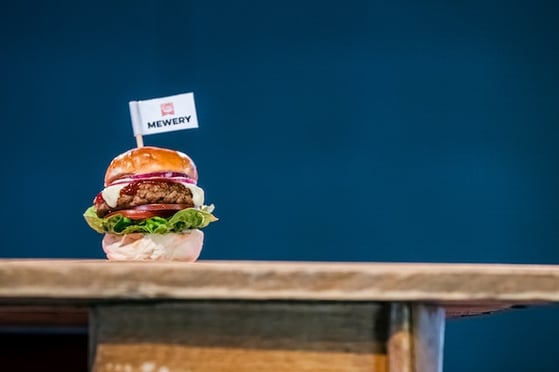
Every year triggers a feeding frenzy of trend forecasts. The big buffet of data and intel, however tempting, offers so many contrasting perspectives and overlapping opinions that it all can become a blur.
So we’ve stepped up to the plate and done the digging for you, distilling down an array of forecasts into digestible data points and bite-sized insights to help you stay ahead of the curve in the new year. Here’s a quick read on a few key trends that are sure to pick up speed in 2024 and beyond.
Click each trend listed below to quickly jump for more info:
- Precision fermentation
- Upcycling
- Health and wellness
- Plant-based foods
- Lab-grown meats
- Newstalgia mashups
- Complex heat and "swicy" flavors
- Modern Korean fine dining
- AI and AR
Precision fermentation
 An emerging technology that uses microbes to produce animal-free functional food ingredients, the process behind precision fermentation is similar to how beer is brewed. The technology has been used for more than 50 years to produce food additives and enzymes like rennet or medicines such as insulin. It has only recently been used to produce food ingredients.
An emerging technology that uses microbes to produce animal-free functional food ingredients, the process behind precision fermentation is similar to how beer is brewed. The technology has been used for more than 50 years to produce food additives and enzymes like rennet or medicines such as insulin. It has only recently been used to produce food ingredients.
Examples of companies using precision fermentation include Perfect Day, New Culture and Change Foods for their animal-free dairy proteins, Impossible Foods heme protein and Onego Bio, who is producing the first animal-free egg white protein, Bioalbumen™ (pictured to the left).
With an estimated value of $2.3 billion in 2023, the global market for precision fermentation-based ingredients is projected to grow and exceed $30 billion by 2030.
Earlier this year, several global companies founded the Precision Fermentation Alliance to help champion the technology as a trusted solution for a more resilient and sustainable food system.
Upcycling
An integral part of sustainability in the food industry, upcycling — or the repurposing of byproducts and discarded ingredients — has become increasingly prevalent.
Over a third of all food produced with an estimated worth of $230 billion is lost or wasted each year. Upcycling enables companies and consumers to produce delicious and nutritious products from food remnants that would otherwise go to waste. The budding upcycled food market is projected to grow 5% annually, with brands like Upcycled Foods Inc., which produces snack bars, pasta and other items made from spent grains, leading the charge.
Health and wellness
.jpg?width=227&height=340&name=kim-daniels-RYhNPglUSFw-unsplash%20(1).jpg) Another interesting trend — food and beverage options with wellness benefits. According to Datassential, it’s one of the top food trends for 2024 because 68% of consumers plan to drink more water and exercise more as part of their prioritization of health.1
Another interesting trend — food and beverage options with wellness benefits. According to Datassential, it’s one of the top food trends for 2024 because 68% of consumers plan to drink more water and exercise more as part of their prioritization of health.1
Expect flavors with a wellness halo like ginger, lemongrass and turmeric to be in high demand as the desire for healthy choices continues to influence flavor development. Functional foods and beverages continue to gain popularity as a form of preventative health care, with 64% of consumers describing their approach to health as proactive.
According to Jasmin Masri, technical sales and marketing coordinator for Custom Flavors, authentic fruit flavors are trending — especially flavor profiles such as black raspberry, goji-strawberry combinations and açai-cherry blends. “Juicy and sweet berry combinations are stealing the spotlight,” she said.
Plant-based foods
 Meat alternatives remain a hot-button issue heading into 2024 as ethical and environmental concerns continue to grow regarding the production and manufacturing of meat-based products.
Meat alternatives remain a hot-button issue heading into 2024 as ethical and environmental concerns continue to grow regarding the production and manufacturing of meat-based products.
“I believe we are moving away from the plant-based meats of the world,” says Chef Sydney Yocum of consultancy Creative Food Solutions. “I think that once people actually read the ingredients they realize that it is full of fillers and preservatives.”
Trend researcher Hanni Rützler, one of Europe’s foremost food experts, predicts that heightened climate and environmental consciousness and the ethical rejection of mass meat production, especially among younger consumers, will make plant-based food a major trend for 2024.
Mushrooms and algae are growing in popularity and potential as plant sources of protein. Nutrient-dense, protein-rich and efficient to grow, mushrooms have a natural meaty taste and texture, unlike other plant-based substitutes that require more processing. Algae is trending as a superfood that can be grown in water, with no need for agricultural land and a market size estimated to reach $18 billion by 2033.
Whole Foods Market forecasts that “Put the ‘Plant’ Back in Plant-Based” will be a top trend in 2024 as labels shrink and simplified options gain traction. “We’re seeing new and emerging protein-forward products with mushrooms, walnuts, tempeh and legumes in place of complex meat alternatives,” the specialty supermarket for natural and organic foods reports. “Even plant-based milk alternatives are participating, with some brands simplifying labels to just two ingredients — perfect for the vegetarian purist.”
Lab-grown meats
 International food and restaurant consultants Baum + Whiteman point out that sales of plant-based products have wilted in recent years. The 20% drop in sales from July 2022 to July 23 is, according to them, based on “taste deficits and poor value in an inflationary economy.” It’s why they foresee a shift to lab-grown proteins as capital investment in them and technological advancements in their development continue to grow.
International food and restaurant consultants Baum + Whiteman point out that sales of plant-based products have wilted in recent years. The 20% drop in sales from July 2022 to July 23 is, according to them, based on “taste deficits and poor value in an inflationary economy.” It’s why they foresee a shift to lab-grown proteins as capital investment in them and technological advancements in their development continue to grow.
“No beaks, no feathers, no hooves ... no coops, no poops ... no animal rights protesters,” asserts Baum + Whiteman. “(The meat industry contributes to about 30% of the world’s greenhouse gasses.) Lab-grown meat is gaining kosher and halal approvals, including pork, maybe. Even some vegetarians are open-minded.”
Rützler also cites lab-grown (aka “cultured”) meat for its potential as a source of more sustainable food production. Mewery, for example, is a European startup cultivating pork meat with a proprietary microalgae base (pictured left).
While sales of plant-based foods may have lagged, technological advancements could lead manufacturers to replicate the taste and textures of meats more closely while improving cost efficiencies — a development that could revitalize the segment in 2024.
Newstalgia mashups
 When thinking of “newstalgia,” think comfort foods like mac and cheese or scrambled eggs kicked up with kimchi or smoky chipotle. Classic nostalgic flavors with an updated or unexpected twist are poised for growth.
When thinking of “newstalgia,” think comfort foods like mac and cheese or scrambled eggs kicked up with kimchi or smoky chipotle. Classic nostalgic flavors with an updated or unexpected twist are poised for growth.
Mintel found that 38% of U.S. consumers surveyed overall like flavors that remind them of their childhood — a percentage that rises to 44% for men aged 35-54 and 41% for males 55 and older.
Datassential research reveals a strong taste for nostalgia as well, with 57% of survey participants expressing interest in nostalgic desserts.1 And the trend holds true for younger demographics too. Sixty-two percent of Gen Zers gravitate to desserts like Viennetta ice cream cake that were hits in the ’90s.2
As a result, we can expect fresh spins on old favorites to strike an appealing balance between nostalgia and novelty. Jaime Lynn Lawrence, R&D application scientist for the flavor innovation company Flavor Insights, cites Rocket Pop, rainbow sherbet, s’mores and dipped waffle cone as nostalgic flavors poised for 2024 prominence.
“We will continue to see more comfort nostalgic flavors and blurring of these flavors, such as alcoholic flavors inspiring sweet and savory foods, [and] dessert-inspired flavors in beverages and meals,” said Soumya Nair, global consumer research and insights director for Kerry Group.
Complex heat and "swicy" flavors
 The Institute of Food Technologists forecasts that the sweet and spicy (aka “swicy”) trend will escalate into more potent palate-pleasing combinations. “The bolder, the better when it comes to innovating with unusual and unexpected flavor pairings,” said Shannon Cushen, director of marketing for Fuchs North America, “so brands should look to the ingredients that are gaining in popularity for their complex and distinct flavor profiles.”’
The Institute of Food Technologists forecasts that the sweet and spicy (aka “swicy”) trend will escalate into more potent palate-pleasing combinations. “The bolder, the better when it comes to innovating with unusual and unexpected flavor pairings,” said Shannon Cushen, director of marketing for Fuchs North America, “so brands should look to the ingredients that are gaining in popularity for their complex and distinct flavor profiles.”’
IFT cites Fuchs’ Back-to-Basics Collection of seasonings, which intensifies the five basic tastes of sweet, salty, sour, bitter and umami, as a forerunner of a new wave of swicy flavors to trend in 2024.
When it comes to complex spice, Whole Foods Market cites the growing popularity of global peppers as an example of this trend. “Specialty varieties like Scorpion Peppers, Guajillo or Hungarian Goathorn Peppers are found fresh, whole, ground or pickled, and a new wave of botana sauces and chili oils are popping up in condiment aisles nationwide,” the retailer reports. Pepper-infused drinks like canned tepache and Tajín-spiced grocery store sushi are other examples of bolder and broader applications for heat.
Modern Korean fine dining
 While LA is considered the hub of Korean food in the U.S., modern Korean fine dining restaurants are taking off in NYC, thanks to the culmination of countless Korean chefs who’ve come to the states to embark on their culinary journey in institutions like the Culinary Institute of America. This influx of ambitious cooks was observed about 10-15 years ago.
While LA is considered the hub of Korean food in the U.S., modern Korean fine dining restaurants are taking off in NYC, thanks to the culmination of countless Korean chefs who’ve come to the states to embark on their culinary journey in institutions like the Culinary Institute of America. This influx of ambitious cooks was observed about 10-15 years ago.
We are now witnessing it all come to fruition, as these cooks are now chef-owners of some of the world’s hottest restaurants; being recognized by publications like The New York Times and Michelin Guide.
“While food trends like kimchi, gochujang and of course, Korean barbecue are ubiquitous on menus across the country in numerous facets of the food industry,” says Chef Ben Lee of Creative Food Solutions. “I feel other Korean ingredients and cooking techniques will become mainstream as food trends set the gold standard approach to the rise of this culture’s cuisine.”
AI and AR
Artificial intelligence is at the top of everyone’s minds. And its ability to help consumers make informed purchasing decisions based on their food preferences and dietary needs cannot be overstated. It’s why companies like Wendy’s are enhancing and personalizing their operations for the consumer by automating the drive-thru experience with AI.
The market research firm Mintel foresees AI taking augmented reality to a new level as a tool to help consumers streamline meal planning, shopping and cooking.
“In the next few years, as AR hardware becomes more sophisticated and less expensive, a key function of food and drink brands will be to guide users through day-to-day activities such as cooking, providing instructions in front of their eyes during tasks and alerting them to any missteps or imminent complications,” said Ayisha Koyenikan, associate director, Mintel Food & Drink.3
In a nutshell, trends tied to wellness, sustainability and technology and the interrelations between them will loom large in 2024. As always, innovation is key as brands and manufacturers continue to adapt to an ever-evolving business landscape.
To stay on top of food and beverage brand and marketing trends, be sure to subscribe to The Front Burner, our agency e-newsletter packed with info to keep you in the know. Crave custom culinary solutions? Reach out to our food innovation consultancy, Creative Food Solutions.
1 Datassential, Foodbytes: 2024 Trends, 2023
2 Datassential, Foodbytes: Dessert Decadence, 2023
3 Mintel, 2024 Global Food & Drink Trends Report, 2023